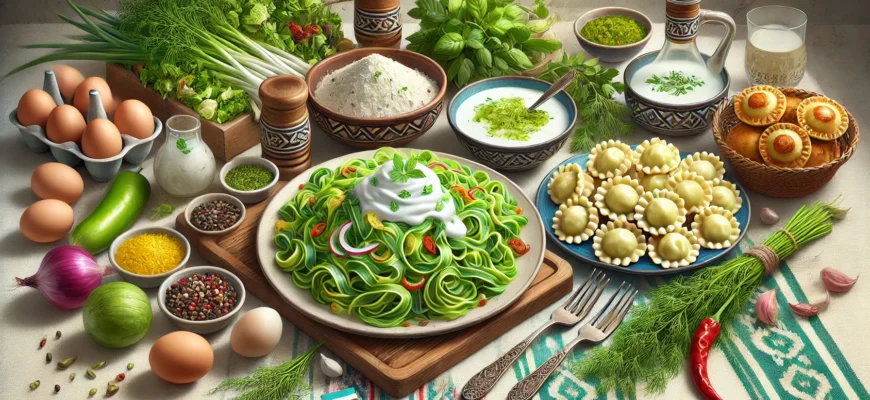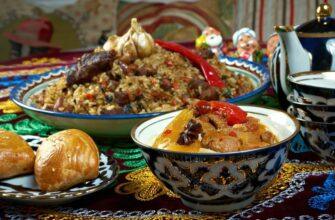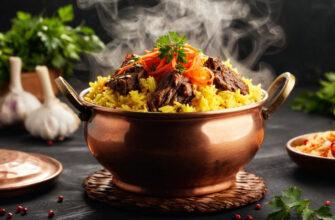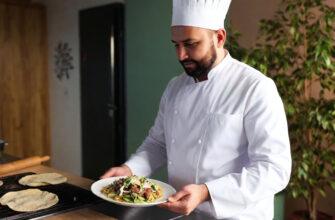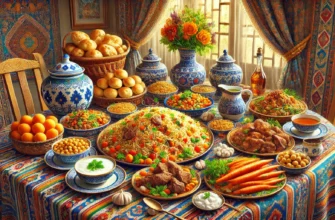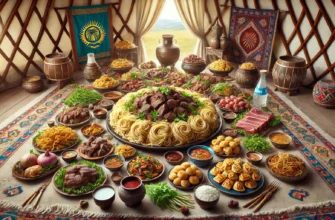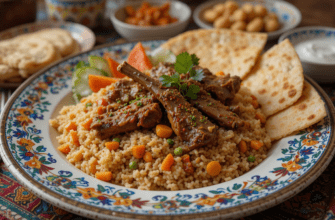Nestled in the heart of Central Asia, Khorezm is a hidden gem boasting a culinary heritage as rich and diverse as its historical tapestry. Renowned for its intricate flavors and traditional cooking styles, Khorezm cuisine offers a fascinating glimpse into the region’s cultural mosaic, shaped by centuries of history and cross-cultural exchanges. From its unique ingredients to its distinctive dishes, Khorezm fare invites food enthusiasts to embark on a mouthwatering journey through the past and present of this vibrant region.
Understanding Khorezm cuisine requires delving into its rich history, where ancient trade routes like the Silk Road influenced its flavors and techniques. Central to its gastronomic identity are key ingredients like succulent meats, fragrant spices, and hearty breads, all prepared using time-honored methods that enhance their natural flavors. Signature dishes such as tuxum barak, shivit oshi, and manty not only exemplify the local palate but also tell the story of a people deeply connected to their land and its bounty.
This article will tantalize your taste buds with an exploration of Khorezm’s culinary delights, featuring iconic dishes, street food experiences, and traditional meal preparations. We’ll uncover the cultural significance of food sharing within this community and offer tips for recreating these authentic dishes at home. Delve into the rich world of Khorezm cuisine and discover how its unique flavors continue to influence Uzbek food today.
The Rich History of Khorezm Cuisine
Khorezm cuisine, a captivating branch of Uzbek cuisine, is known for its rich use of fresh herbs and vegetables. It’s a sensory journey that celebrates vibrant colors and unique infusion techniques. A great example is Shivit Oshi, with its dill-infused green noodles— a vivid and popular dish.
Seasonality plays a key role in Khorezm cuisine. Dishes like Mador Samsa are crafted using fresh spring herbs, reflecting the region’s deep connection to its environment. This ties in with their tradition of dumplings. Tukhum-barak, an original dish, showcases their inventive flavors and textures.
Khorezm’s culinary heritage runs deep, with its bustling bazaars filled with spices and textiles. These markets anchor the cuisine in a broader cultural context, giving each dish a story and significance.
Here’s a quick overview of some beloved dishes:
| Dish | Key Ingredients | Unique Feature |
|---|---|---|
| Shivit Oshi | Green noodles, dill | Bright and colorful with a rich taste |
| Mador Samsa | Fresh spring herbs | Seasonal, hearty dish |
| Tukhum-barak | Dumplings with juicy filling | Inventive approach to flavors and textures |
Key Ingredients of Khorezm Dishes
Khorezm cuisine is rich in flavors and unique ingredients. One standout ingredient is fresh dill, which gives Shivit Oshi its green hue. These green noodles are a beloved dish in Uzbek cuisine. Fresh herbs and vegetables are common, setting Khorezm apart from other Central Asian cuisines.
Key Ingredients:
- Dough and Eggs: Tuxum Barak is made with a mixture of flour, eggs, water, and salt. It’s a traditional dish known for its omelet-like, fluffy filling.
- Sour Cream and Yogurt: These serve as popular toppings, adding a rich taste to many dishes.
- Meat and Vegetables: Often used as toppings, they pair well with the simple doughs and add a hearty touch to meals.
A favorite dish of Khorezm can combine these ingredients in a variety of ways, creating a wide variety of flavors and experiences. Fresh herbs contribute a distinct flavor, while sour cream or plain yogurt offer a creamy texture. Whether for special occasions or everyday meals, the ingredients used in Khorezm cuisine make their dishes both flavorful and unique.
Traditional Cooking Techniques
Khorezm cuisine showcases unique cooking techniques found in traditional Uzbek cuisine. One such specialty is Tuxum Barak. These egg dumplings are filled with raw beaten egg and boiled, allowing the filling to cook rapidly inside the tender dough.
The clay tandoor oven is central to many Uzbek dishes, including naan. In this method, the dough is baked directly on the oven walls, giving it a rich and authentic flavor.
Uzbek dumplings, like Chuchvara, offer versatile cooking methods. They can be fried or boiled and are often served with sour cream or yogurt for added richness.
Samsas are another popular dish in Khorezm. Creating the flaky pastry involves mixing flour with warm water, oil, and salt before baking them in a tandoor or regular oven.
Here’s a quick recap of popular Uzbek dishes:
| Dish | Key Ingredient | Cooking Method |
|---|---|---|
| Tuxum Barak | Egg | Boiling |
| Chuchvara | Ground beef or lamb | Boiling/Frying |
| Samsas | Minced meat/vegetables | Baking |
| Khanum | Minced meat/potato | Steaming |
These techniques highlight the region’s preference for hearty and richly flavored dishes, perfect for special occasions.
Signature Khorezm Dishes
Khorezm cuisine is a remarkable facet of Uzbek culinary tradition, centered in the historic city of Khiva. The region offers a distinct culinary experience through its unique dishes, such as shivit oshi and tuxum barak. Chefs in Khorezm focus heavily on fresh ingredients, using herbs and vegetables to create vibrant meals. This approach sets it apart from other Uzbek regions, known for their own versions of Central Asian dishes. Khiva, with its rich cultural backdrop, is the perfect place to enjoy these original creations. The variety and flavor of Khorezm’s cuisine make it a must-visit spot for any food enthusiast.
Tuxum Barak: Khorezm Egg Dumplings
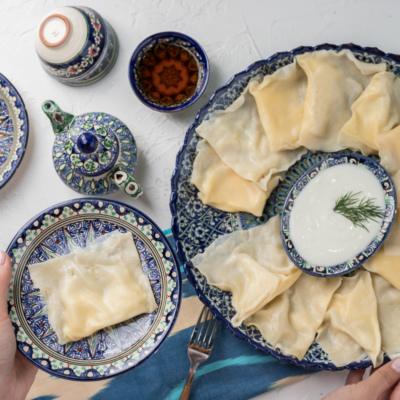
Tuxum Barak, or Tukhum Barak, stands as a beloved dish of the Khorezm region. These are traditional egg dumplings, unique in their preparation and ingredients. The dough, crafted from flour, water, eggs, and salt, encases a distinctive filling. This filling is made of raw beaten eggs mixed with milk, butter, and seasonings, offering a rich taste. The dumplings are shaped into squares with small openings, allowing for boiling water to be added before cooking. The preparation and flavor make Tuxum Barak a noteworthy representative of Khorezm’s culinary heritage.
Shivit Oshi: Green Noodles
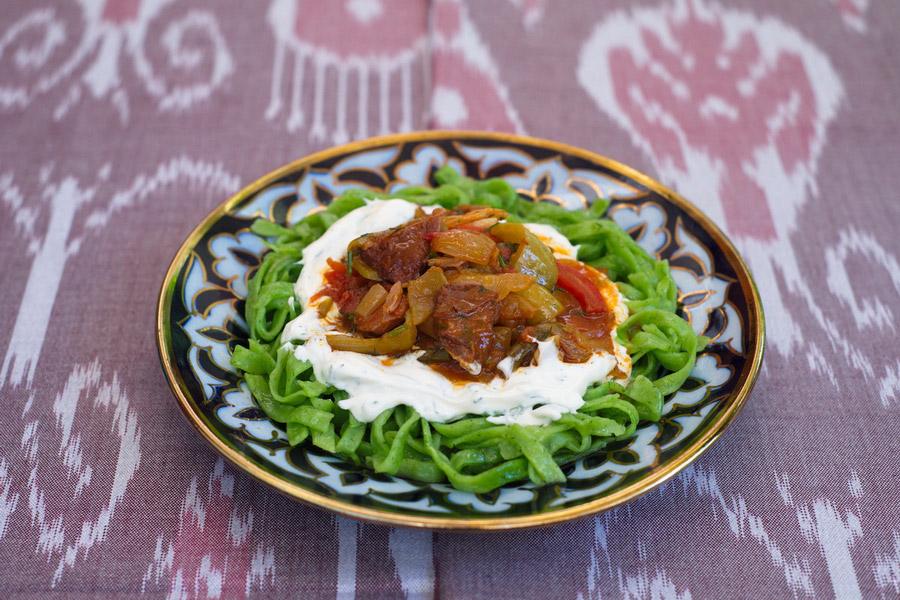
Shivit Oshi is a signature dish from Khorezm, highly praised for its vibrant green noodles. The noodles get their color from fresh dill, a staple in this part of Central Asia. The dish is traditionally served with a savory stew made of meat and vegetables, enhancing its delightful flavors. Accompanied by sour cream or plain yogurt, shivit oshi provides a refreshing dish, especially popular in the summer months. Its rise to fame beyond Khorezm was aided by Chef Rajab Sattarov, who took this recipe to Tashkent in 1958. Today, it’s commonly found in Khiva’s restaurants, celebrated for its original taste and presentation.
Khanum: Layered Steamed Dumplings
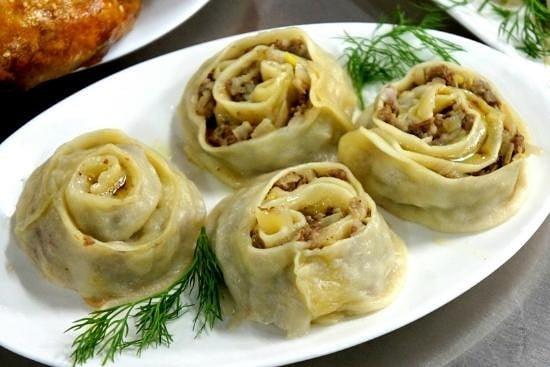
Khanum, also referred to as hanum or hanon, highlights the versatility of Uzbek cuisine through its unique preparation. As a steamed flour dish, it envelops fillings like potatoes, minced meat, or pumpkin. The dough wraps these fillings to create a juicy, flavorful combination. Khanum can also be called urama in regions like the Fergana valley, suggesting its wide variety of presentations, from roses to rolls. It’s a prevalent offering in national restaurants and Uzbekistan bazaars, often ready-made, showcasing the regional preference for hearty and beautifully presented dishes.
Manty: Uzbek-Style Dumplings
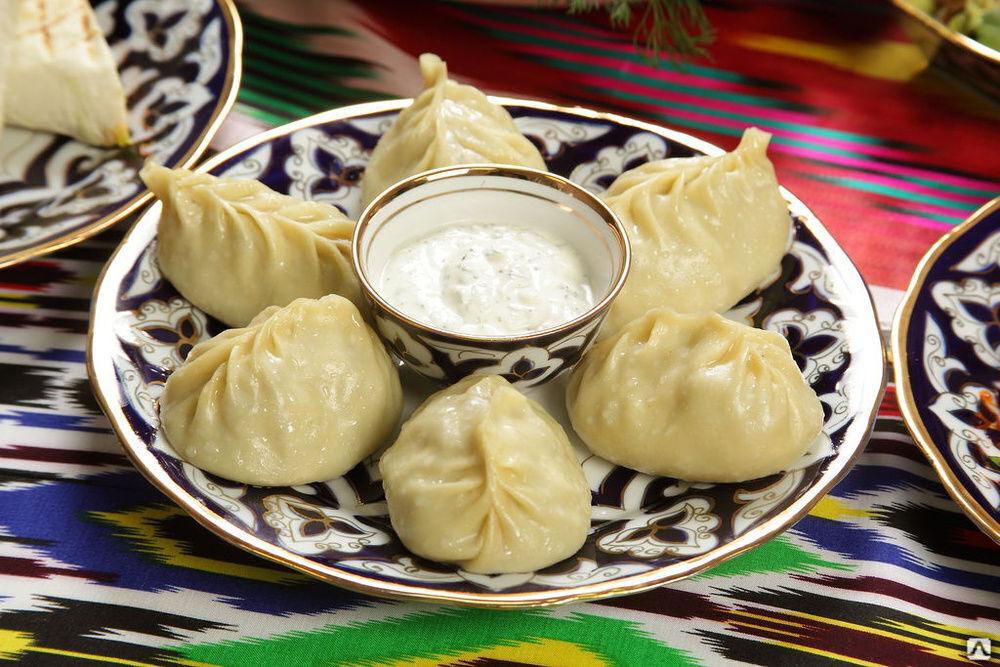
Manty, or manti, is a popular dish in Central Asia, celebrated for its hearty and juicy filling. These dumplings are prepared using unleavened dough, filled with minced beef or lamb, onions, and sometimes lamb fat. The dough should be rolled thin to enhance the dumpling’s flavor. Seasonal ingredients like pumpkin, potatoes, and spinach often appear in homemade manty, adding variety and richness. Typically served with sour cream or yogurt, they are often topped with melted butter or oil. This preparation highlights the dish’s ability to stay true to its Uzbek roots while evolving with different flavors.
Accompanying Dishes
Khorezm cuisine, a part of Uzbek culinary tradition, is rich and diverse, featuring various dishes that complement the main course. One beloved dish is plov, a rice pilaf typically served during special occasions like weddings. It is a hearty dish that brings families together. Another popular dish is shashlik, which includes skewered and grilled meats such as beef, lamb, or chicken. Often, it is presented with fresh vegetables like tomatoes and cucumbers to balance its rich taste. Lepyoshka, a type of round and flat bread, is ever-present at meals, offering people a taste of tradition. During the Nooruz celebrations, green samsa, a delightful pastry, is a favored addition to meals. Khorezm’s tukhum-barak, an original dish of square-shaped dumplings filled with raw eggs, adds a unique element to any dining experience.
Aromatic Soups and Stews
In the heart of Uzbek cuisine lie aromatic soups and stews, each offering a unique taste and delightful experience. These soups are staples in Central Asian kitchens, bringing warmth and comfort to any table. Shurpa, a flavorful Uzbek dish, combines meat, potatoes, carrots, and onions with various spices. This hearty soup is cherished for its ability to bring out the flavors of its simple ingredients. Mastava offers a twist with its addition of sour milk, pepper, and greens. Known for its rejuvenating properties, cholop is a cold soup with cucumbers, radish, and greens mixed with sour milk. Meanwhile, mashkhurda is a nutritious delight, featuring green gram, rice, potato, and often sour milk and onions. Lastly, lagman, a noodle soup enriched with vegetables and meat, is a beloved dish celebrated for its depth and variety.
Succulent Meats
Uzbek cuisine is known for its succulent meats, a testament to the region’s rich culinary traditions. These meats are skillfully prepared in various ways, capturing the essence of traditional Central Asian flavors. A well-spiced favorite, shashlik features skewered, grilled meats like mutton, beef, and chicken. Each bite is juicy, tender, and packed with a rich taste, making it a popular dish for many. Hearty soups like mashhurda often include beef, mixed with vegetables and mung beans, showcasing a blend of textures and flavors. In the Khorezm region, the unique Khorezm Kebab stands out. It features thinly sliced, well-cooked beef served with fresh vegetables and a spicy tomato sauce.
Hearty Breads: Tandyr Non
Tandyr Non is more than just bread in Uzbek cuisine; it is a cultural symbol. Known also as Lepyoshka, this round bread holds a sacred status among Uzbek people. Baked in traditional clay tandoor ovens, Tandyr Non carries a distinct flavor and texture unique to this region. During meals, it is customarily broken by hand and shared among diners, symbolizing hospitality and community spirit. The tradition of baking this bread is treated with deep respect. Bread is never placed on the ground or faced down, displaying the reverence held for this staple. Across Uzbekistan, there are regional variations of Tandyr Non. In Tashkent, Patir Naan reigns, while an onion-infused version is popular in Samarkand. Each variation offers a taste of the region’s cultural and culinary nuance.
Street Food and Market Experiences
Street food and market experiences in Uzbekistan offer a delightful glimpse into the country’s rich culinary and cultural heritage. One standout location is the Choru street food market in Tashkent. Here, visitors can savor Uzbek samsa and dumplings. These dishes, although commonly found in covered markets, are a must-try. Especially noteworthy is the samsa, a crispy, triangular pastry baked in a clay tandoor oven. It comes with a variety of fillings, such as minced meat, giving it a rich taste.
Markets in Uzbekistan are not just about food; they are also about the entire sensory experience. Wine tastings are a popular attraction, offering tours and samples from local wineries. These tastings highlight vintages made from both classic and regional grape varieties. Uzbekistan’s viticulture has a history spanning several millennia, influenced by figures such as Alexander the Great and Russian Tsarist conquests.
For anyone exploring Uzbek street and market culture, these experiences are not to be missed.
Here’s a quick list of must-try market experiences:
- Uzbek Samsa
- Dumplings
- Wine Tastings
- Market Tours
Each element showcases the vibrant and diverse landscape of Uzbek cuisine and culture.
Celebratory Meals and Culinary Traditions
Uzbek culture is rich with traditions that center around food and togetherness. A celebrated meal often includes plov, a renowned dish made of meat, rice, vegetables, and spices. Plov is more than just food; it represents Uzbek hospitality and is even listed as a UNESCO Intangible Cultural Heritage.
The dastarkhan is another cornerstone of Uzbek dining. This Central Asian ritual involves sharing a variety of dishes with friends and family around a full table. It’s a tradition where culinary delights come alive.
Tea, especially green tea, plays an indispensable role during these meals. Served in a chaikhana, or tea house, it aids digestion and refreshes the palate.
Uzbekistan’s culinary practices reflect its vibrant multicultural heritage along the former Silk Road. This influence can be tasted in the unique mix of flavors and cooking techniques.
Below are elements each celebratory meal might include:
- Plov: Hearty centerpiece
- Tea: Digestive aid
- Noodle Soups: Comforting, flavor-rich
- Meat Dishes: Skewers, sausages, and juicy fillings
These traditions make Uzbek cuisine a beloved part of Central Asian culture, known for its unparalleled hospitality.
Khorezm Cuisine Comparisons: Influence on Uzbek Food
Khorezm cuisine is a unique subset of Uzbek cuisine, known for its distinct regional dishes. It includes tukhum-barak, a beloved dish with a juicy filling made from eggs and pasta. This region also brings us shivit oshi, which features green noodles infused with dill, offering a rich taste.
Khorezm food utilizes local ingredients through unique cooking techniques. This highlights the broader Uzbek culinary landscape, which is influenced by Uzbekistan’s history as a Central Asian trade crossroads. These dishes reflect diverse cultural exchanges, adding to the wide variety of Uzbek dishes.
Key Khorezm Dishes:
- Tuxum Barak: A traditional and hearty dish with a meat or egg filling.
- Shivit Oshi: Dill-infused green noodles creating a distinct flavor.
Both dishes showcase Khorezm’s contribution to Uzbek cuisine, with innovative use of common ingredients. The culinary traditions of Khorezm highlight its role in shaping the broader heritage of Uzbek cuisine.
| Dish | Key Ingredients | Unique Features |
|---|---|---|
| Tukhum Barak | Eggs, Pasta | Juicy filling |
| Shivit Oshi | Green Noodles, Dill | Distinct dill flavor |
Khorezm’s rich and original dishes demonstrate the region’s impact on Uzbekistan’s culinary scene.
Wine and Beverage Pairings
Wine has been a part of Uzbek culture for thousands of years. It pairs wonderfully with Khorezm cuisine. The rich wines of Uzbekistan, like those from the Bagizagan winery, complement the diverse Uzbek dishes beautifully.
Here is a simple guide to pairing wine with Khorezm dishes:
- Hearty Dishes: Pair with a dry red like Saperavi. Its bold flavor complements meat skewers or sausages.
- Cold Soups: Try a light, refreshing white wine. It pairs well with cold soups like plain yogurt or sour cream-based dishes.
- Noodle Dishes: Green noodles or Uzbek-style noodle soup work well with a medium-bodied rosé.
- Dishes with Rich Tastes: Full-bodied wines like Cabernet can enhance the flavors of a juicy filling or hearty soup.
- Sweet Treats: End your meal with a sweet regional blend like Bayan Shirey.
With these wine pairings, you can make special occasions even more enjoyable. By understanding which wines match your favorite dishes, you can enhance the original flavors. Enjoy the wide variety of rich tastes that both Uzbek wine and cuisine have to offer.
Where to Experience Khorezm Cuisine
Khorezm cuisine offers a distinct taste of Central Asian flavors, primarily in the city of Khiva. The region is celebrated for dishes like Shivit Oshi, renowned for its bright green noodles made with dill. Experience this beloved dish at local spots such as the Khorezm Art Restaurant. Here, you’ll find a blend of regional specialties and international cuisine.
When in Khiva, do not miss trying Tuxum Barak. This traditional Uzbek dish features dumplings with a juicy egg filling. It is cooked uniquely, with the egg mixture sealed within the dough. The dish provides a delightful burst of flavors with each bite.
Visitors can also explore vibrant markets filled with fresh herbs and local spices. These ingredients are key to the rich taste and originality of Khorezm dishes. Many restaurants here embrace this tradition by crafting dishes with ground beef, sour cream, and black pepper, offering a hearty dining experience.
For those keen on an authentic experience, visit one of the local eateries that use clay tandoor ovens. This traditional cooking method enhances the flavors, ensuring a hearty and satisfying meal. Experience the original taste of Khorezm and be part of its rich culinary tradition.
Conclusion: The Cultural Significance of Food Sharing
In Urgench, a city in Uzbekistan, food sharing is a cherished tradition. It strengthens social bonds and is a central part of the communal lifestyle. During special occasions, families gather to enjoy traditional Uzbek dishes, creating a heartfelt dining experience.
Uzbek hospitality shines through when hosts invite guests to share meals at home. This gesture underscores the importance of culinary traditions in the region. Central Asian dining rituals, such as the dastarkhan, further emphasize this cultural practice. Here, meals are celebrated with friends and family gathered around a table filled with diverse dishes.
Historically, the Silk Road played a crucial role in exchanging culinary customs, enriching Uzbek cuisine. This historical influence is evident in the wide variety of dishes that blend local ingredients with foreign-inspired flavors.
Key Aspects of Uzbek Food Sharing:
- Traditional Dishes: Often served during special occasions.
- Communal Dining: Reinforces bonds and enhances hospitality.
- Cultural Rituals: The dastarkhan celebrates togetherness.
- Diverse Cuisine: Silk Road exchanges led to a rich culinary tapestry.
In conclusion, food sharing in Urgench is more than just a meal; it’s a cultural expression and a celebration of togetherness.
Tips for Making Khorezm Dishes at Home
Khorezm cuisine is a delightful part of Uzbek cuisine, known for its original dishes. Here are some tips to make Khorezm dishes at home.
Tukhum-Barak (Khorezm Dumplings):
- Boil the dumplings just enough to cook the dough. The egg filling cooks in the first minute.
- After boiling, grease them with butter to prevent sticking.
Shivit Oshi (Green Noodles):
- Make a dill infusion to give the noodles their distinctive green color.
- Serve them with beef stew, sour cream, or plain yogurt for a rich taste.
Tuxum Barak (Khorezm Ravioli):
- Use a combination of flour, eggs, water, and salt for the dough. This ensures the right consistency.
Family Preparation:
- Make the process a family activity. This enhances the communal aspect and makes the experience more enjoyable.
Here’s a simple table for the key ingredients:
| Dish | Key Ingredients |
|---|---|
| Tukhum-Barak | Egg filling, dough, butter |
| Shivit Oshi | Dill, beef stew, sour cream |
| Tuxum Barak | Flour, eggs, water, salt |
Try these beloved dishes and enjoy the wide variety of flavors Khorezm cuisine offers!
Resources for Further Exploration
To dive deeper into Khorezm cuisine and its Uzbek origins, consider exploring the following resources:
- Books: Look for cookbooks focused on Uzbek cuisine. Titles like “Samarkand: Recipes & Stories from Central Asia & the Caucasus” offer authentic recipes and cultural insights.
- Online Cooking Videos: Platforms like YouTube host a wide variety of cooking tutorials, guiding you through making popular dishes such as Plov, Tuxum Barak, and Tandoor kebabs.
- Culinary Blogs: Many food bloggers specialize in Uzbek dishes, providing step-by-step recipes and personal experiences with ingredients like sour cream, ground beef, and black pepper.
- Cooking Classes: Enroll in local or virtual classes that focus on Central Asian cuisine to gain hands-on experience with traditional dishes, including cold soups and juicy fillings.
- Cultural Events: Attend events celebrating Uzbek culture where you can sample a range of beloved dishes prepared using traditional methods like the clay tandoor oven.
By tapping into these resources, you can enjoy the rich taste and hearty soups that define Khorezm cuisine and truly appreciate its distinct culinary heritage.

